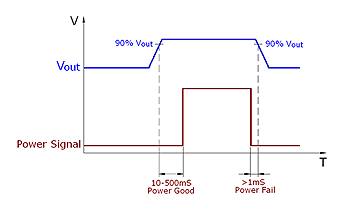What is Power Good Signal?
The power good signal is a +5 volts signal that is generated by a switching power supply when the supply has stabilized its output voltages and passed all its internal self-tests. The is usually generated after s a period of between 0.1 seconds and 0.5 seconds after turning on the power supply.
The power supply is usually designed with the normal voltage outputs to supply the various circuits and components of the computer. In addition to these voltages, a power good signal is added to ensure that all the required voltages are always stable for the designed computer operation. This ensures that the magnitude of the voltages do not rise or fall to abnormal levels that would risk the proper operation of the delicate computer circuits.
The computer processor is designed to monitor the power and only start operations once all the required power conditions are met. This avoids the possibility of the computer starting on unstable voltages which can damage the mother board components and other computer devices such as hard disks. Once the power supply is turned on and stabilized its designed output voltages with no faults, the power good signal is sent to the processor to inform the computer that the supply is operating well and all required voltages and currents are available for the proper operation.
The motherboard relies on the processor timer chip which manages a reset line to the processor. As long as the power good signal is absent, the timer chip applies a constant reset signal to the processor and the computer cannot turn on. Once the power supply completes its initialization and stabilizes its outputs, the power good signal is sent to the timer chip which in turn stops resetting the processor. The processor now starts the computer boot up process and executes the code at the FFFF:0000 address which is normally the ROM BIOS.
The power supply diagnostics continuously monitors its outputs and stability of the supply, in case a fault or unstable voltages due to brownouts, deteriorated components, or input supply issues, the power good signal is withdrawn. This causes the timer chip to reset the processor continuously and thereby turn off the computer operations. Once the power supply resumes its normal and stable output voltages, the power good signal is again regenerated and sent to the timer chip to restart the computer operation.
Once a bad power situation detected, the computer is permanently reset and stopped quickly to avoid malfunction such as parity errors and malfunction. The power good signal therefore ensures that the computer will only operate when it receives the proper voltages and never receives the bad power which is unstable or have improper voltage levels.
